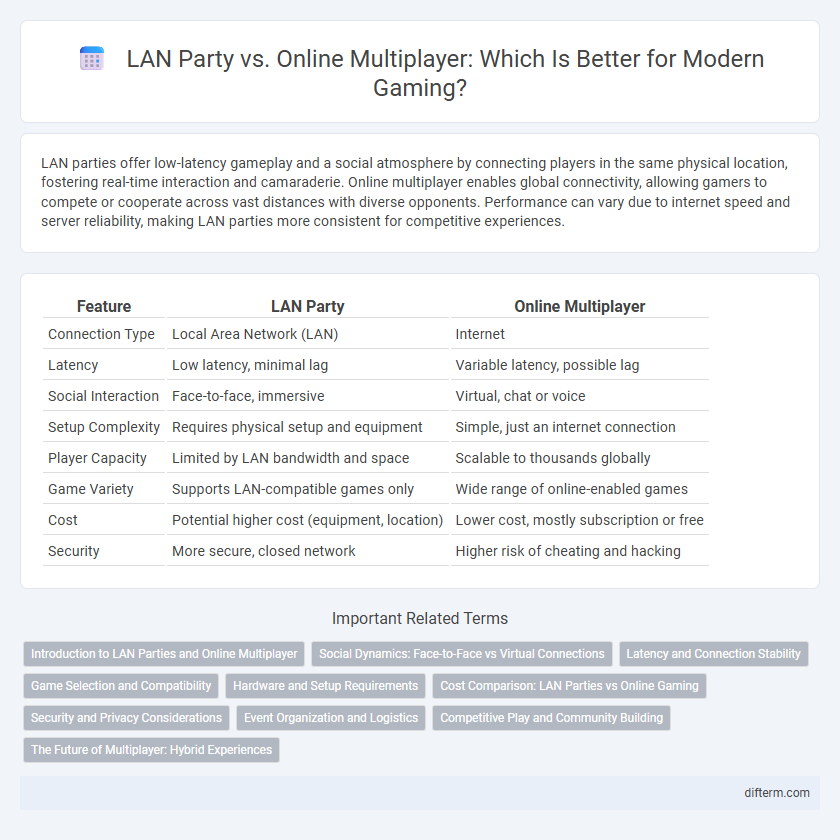LAN parties offer low-latency gameplay and a social atmosphere by connecting players in the same physical location, fostering real-time interaction and camaraderie. Online multiplayer enables global connectivity, allowing gamers to compete or cooperate across vast distances with diverse opponents. Performance can vary due to internet speed and server reliability, making LAN parties more consistent for competitive experiences.
Table of Comparison
| Feature | LAN Party | Online Multiplayer |
|---|---|---|
| Connection Type | Local Area Network (LAN) | Internet |
| Latency | Low latency, minimal lag | Variable latency, possible lag |
| Social Interaction | Face-to-face, immersive | Virtual, chat or voice |
| Setup Complexity | Requires physical setup and equipment | Simple, just an internet connection |
| Player Capacity | Limited by LAN bandwidth and space | Scalable to thousands globally |
| Game Variety | Supports LAN-compatible games only | Wide range of online-enabled games |
| Cost | Potential higher cost (equipment, location) | Lower cost, mostly subscription or free |
| Security | More secure, closed network | Higher risk of cheating and hacking |
Introduction to LAN Parties and Online Multiplayer
LAN parties create a physical environment where gamers connect local devices to enjoy low-latency, high-speed gameplay without internet dependency. Online multiplayer offers global access, enabling players to compete or cooperate from remote locations via internet servers. Both platforms provide unique social and technical experiences that shape gaming dynamics and community interaction.
Social Dynamics: Face-to-Face vs Virtual Connections
LAN parties foster direct social interaction, creating a tangible sense of camaraderie through shared physical space and real-time communication. Online multiplayer gaming builds extensive virtual communities, allowing players worldwide to connect, collaborate, and compete without geographical limits. Both environments shape unique social dynamics, with LAN emphasizing personal presence and online multiplayer prioritizing accessibility and network diversity.
Latency and Connection Stability
LAN parties offer significantly lower latency and more stable connections compared to online multiplayer gaming, as players connect through a local network with minimal signal interference. This direct hardware linkage reduces packet loss and lag, ensuring faster response times and smoother gameplay. Online multiplayer relies on internet infrastructure, which can introduce variable latency and connectivity issues due to bandwidth fluctuations and routing inefficiencies.
Game Selection and Compatibility
LAN parties often allow gamers to choose a wider variety of titles without compatibility issues since all players use the same local network and hardware specifications. Online multiplayer games require careful selection based on server availability, cross-platform support, and stable internet connections to ensure smooth gameplay. Game developers frequently optimize titles for either LAN or online modes, affecting the compatibility and performance experienced by players.
Hardware and Setup Requirements
LAN parties demand robust local network infrastructure, including high-speed Ethernet cables, switches, and powerful gaming rigs to minimize latency and ensure smooth gameplay. In contrast, online multiplayer relies heavily on stable internet connections and server performance, with less emphasis on physical setup but significant importance on bandwidth and ping rates. Optimal hardware for LAN focuses on direct connectivity and minimal interference, whereas online multiplayer prioritizes network security and consistent online service availability.
Cost Comparison: LAN Parties vs Online Gaming
LAN parties generally require upfront costs such as purchasing hardware, networking equipment, and occasional venue fees, but minimize ongoing expenses due to no internet dependency. Online multiplayer gaming often involves subscription fees, stable high-speed internet, and potential in-game purchases, leading to continuous costs over time. Evaluating overall expenses, LAN parties can be a cost-effective choice for localized group play, while online gaming offers convenience with a potentially higher long-term financial commitment.
Security and Privacy Considerations
LAN parties offer enhanced security and privacy by limiting game sessions to a closed local network, reducing exposure to external cyber threats and unauthorized access. In contrast, online multiplayer gaming relies on internet connectivity, increasing vulnerability to data breaches, hacking, and DDoS attacks due to broader network exposure. Players seeking maximum confidentiality often prefer LAN setups to safeguard personal information and game data against potential online security risks.
Event Organization and Logistics
LAN party event organization requires careful coordination of physical space, network infrastructure, and hardware setup to ensure low-latency gameplay and uninterrupted connectivity. Online multiplayer events prioritize server capacity, digital matchmaking algorithms, and global accessibility, minimizing the need for physical logistics but emphasizing robust cybersecurity and latency management. Effective logistics for LAN parties involve transportation, seating arrangements, and power supply planning, while online events focus on bandwidth optimization and real-time server monitoring.
Competitive Play and Community Building
LAN parties offer unparalleled low-latency environments fostering intense competitive play and real-time communication among participants, amplifying teamwork and strategic coordination. Online multiplayer platforms enable expansive community building by connecting gamers globally, offering diverse competitive tiers and tournaments that accommodate various skill levels. Both formats enhance competitive gaming, with LAN parties emphasizing direct social interaction and online play prioritizing accessibility and sustained community growth.
The Future of Multiplayer: Hybrid Experiences
Hybrid multiplayer experiences merge the immediacy and social bonding of LAN parties with the accessibility and scale of online gaming, creating a versatile gaming environment. Advances in cloud gaming and low-latency networking technology support seamless transitions between local and online play, enhancing player engagement across diverse platforms. This evolution promises richer, more immersive multiplayer interactions, combining the best elements of in-person camaraderie and expansive digital connectivity.
LAN party vs online multiplayer Infographic

 difterm.com
difterm.com